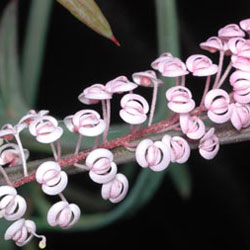Grevillea leptobotrys
 |
 |
Tangled Grevillea
Grevillea leptobotrys, commonly known as Tangled Grevillea, belongs to the Proteaceae family and is endemic to south-west Western Australia. It has been recorded in scattered populations in the area bounded by Cranbrook, Brookton, North Bannister and Shannon, where it experiences hot, dry summers and cool, wet winters. This shrub predominately occurs in eucalypt woodland in gravelly, lateritic soils ranging from sandy loam to clay.
 Grevillea leptobotrys is an extremely diverse species, with many different forms of both habit and foliage. It can range from a low, clumping, dense shrub, to a prostrate mat-forming shrub between 0.1–0.4m high and 1–3m wide. The grey-green leaves, while usually heavily divided into broad, triangular tipped lobes, vary greatly in colour, length and extent of division between plants.
Grevillea leptobotrys is an extremely diverse species, with many different forms of both habit and foliage. It can range from a low, clumping, dense shrub, to a prostrate mat-forming shrub between 0.1–0.4m high and 1–3m wide. The grey-green leaves, while usually heavily divided into broad, triangular tipped lobes, vary greatly in colour, length and extent of division between plants.
Despite this impressive variation, the attractive mauve-pink flowers of this plant are what truly set it apart from others. The delicate racemes form on the ends of branches and in the upper axils, and provide exquisitely perfumed flowers which occur between late spring to the end of summer. Careful pruning can lead to a number of additional flushes throughout the year for those who wish to extend the plant’s unique beauty.
Cultivation of this species away from its natural habitat can present a challenge, as even slight variation from optimal conditions can cause immediate death or a greatly reduced lifespan. Growing from seed is generally effective when seeds are given scarification treatment and soaked in water for 24 hours. However high quality seed for this plant is not often readily available and growing from cuttings is a much more common propagation method. Young, vigorous growth collected in autumn usually strikes successfully, particularly with the application of an appropriate rooting hormone gel. Seedlings should be grown in a high quality native potting mix and kept in an area with cool air temperatures (20–23°C) and high humidity (around 75%).
It is highly recommended that this species be grown in a pot or large pipe as air flow and effective drainage are essential. The plant should be kept in a warm, dry place, preferably in dappled shade, where it is sheltered from both extreme heat and frosts which can be lethal. The soil should be kept moist but never completely saturated; minimal watering (around 1–2 times a week) should occur in winter, with more frequent watering in the summer months to prevent it becoming completely dried out. In addition to this, the plant should be kept well pruned and given slow-release fertiliser when required, to ensure healthy and continued growth.
If it is desired that the plant be grown in the garden rather than a container, a different approach must be taken. While Grevillea leptobotrys will seldom grow in soil on its own roots, grafting onto a hardier rootstock such as Grevillea robusta can be highly effective. To do this, G. robusta or another suitable species (G. shiressii, G. ‘Poorinda Royal Mantle) must be grown from seed until the seedlings are around 10–15 cm in height, and the ‘top wedge grafting’ method used.
While this species has been observed to be generally short lived (3–5 years) even in the wild, its prolific flowering makes cultivation in the home a very worthwhile endeavour.Emily Gardiner, Botanical Intern 2013
Name meaning: Grevillea leptobotrysGrevillea– after Charles Francis Greville (1749–1809), a British patron of botany and co-founder of the Royal Horticultural Society leptobotrys – a Greek compound from leptos, 'fine, slender, weak', and botrys, 'cluster or bunch', alluding to the delicate nature of the inflorescences |
References:
Australian Native Plants Society (2008) Grevillea leptobotrys. Available at http://anpsa.org.au/g-lep.html, accessed 9 Feb 2013.
George, A.S. (1984) An Introduction to the Proteaceae of Western Australia, Kangaroo Press Ltd, Kenthurst, New South Wales.
Olde, P., & Marriott, N. (1995). The Grevillea Book. Volume 1. Kangaroo Press Ltd, Kenthurst, New South Wales.
Olde, P., & Marriott, N. (1995). The Grevillea Book. Volume 2. Kangaroo Press Ltd, Kenthurst, New South Wales.
![An Australian Government Initiative [logo]](/images/austgovt_brown_90px.gif)

